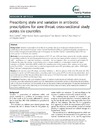Please use this identifier to cite or link to this item:
http://hdl.handle.net/10553/19822
| Title: | Prescribing style and variation in antibiotic prescriptions for sore throat: cross-sectional study across six countries | Authors: | Códoba Currea, Gloria Siersma, Volkert Lopez-Valcarcel, Beatriz Bjerrum, Lars Llor, Carles Aabenhus, Rune Makela, Marjukka |
UNESCO Clasification: | 531207 Sanidad | Keywords: | Sanidad Costes |
Issue Date: | 2015 | Journal: | BMC Family Practice | Abstract: | Background: Variation in prescription of antibiotics in primary care can indicate poor clinical practice that contributes to the increase of resistant strains. General Practitioners (GPs), as a professional group, are expected to have a fairly homogeneous prescribing style. In this paper, we describe variation in prescribing style within and across groups of GPs from six countries. Methods: Cross-sectional study with the inclusion of 457 GPs and 6394 sore throat patients. We describe variation in prescribing antibiotics for sore throat patients across six countries and assess whether variation in "prescribing style" - understood as a subjective tendency to prescribe - has an important effect on variation in prescription of antibiotics by using the concept of prescribing style as a latent variable in a multivariable model. We report variation as a Median Odds Ratio (MOR) which is the transformation of the random effect variance onto an odds ratio; Thus, MOR = 1 means similar odds or strict homogeneity between GPs ' prescribing style, while a MOR higher than 1 denotes heterogeneity in prescribing style. Results: In all countries some GPs always prescribed antibiotics to all their patients, while other GPs never did. After adjusting for patient and GP characteristics, prescribing style in the group of GPs from Russia was about three times more heterogeneous than the prescribing style in the group of GPs from Denmark - Median Odds Ratio (6.8, 95% CI 3.1;8.8) and (2.6, 95% CI 2.2;4.4) respectively. Conclusion: Prescribing style is an important source of variation in prescription of antibiotics within and across countries, even after adjusting for patient and GP characteristics. Interventions aimed at influencing the prescribing style of GPs must encompass context-specific actions at the policy-making level alongside GP-targeted interventions to enable GPs to react more objectively to the external demands that are in place when making the decision of prescribing antibiotics or not. | URI: | http://hdl.handle.net/10553/19822 | ISSN: | 1471-2296 | DOI: | 10.1186/s12875-015-0224-y | Source: | BMC Family Practice [EISSN 1471-2296], v. 16 (1), (Enero 2015) | Rights: | by-nc-nd |
| Appears in Collections: | Artículos |
SCOPUSTM
Citations
36
checked on Mar 30, 2025
WEB OF SCIENCETM
Citations
34
checked on Mar 30, 2025
Page view(s)
101
checked on Sep 22, 2024
Download(s)
189
checked on Sep 22, 2024
Google ScholarTM
Check
Altmetric
Share
Export metadata
Items in accedaCRIS are protected by copyright, with all rights reserved, unless otherwise indicated.
